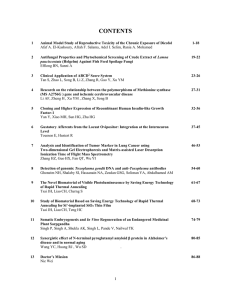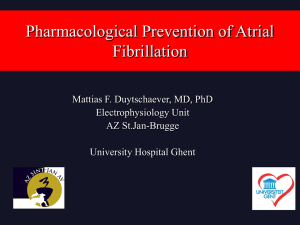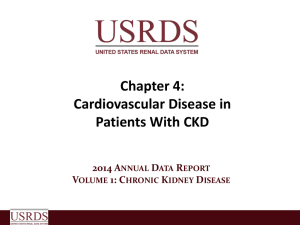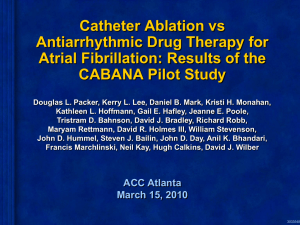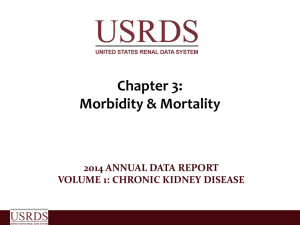Online Appendix for the following JACC articleTITLE: Novel Genetic
advertisement
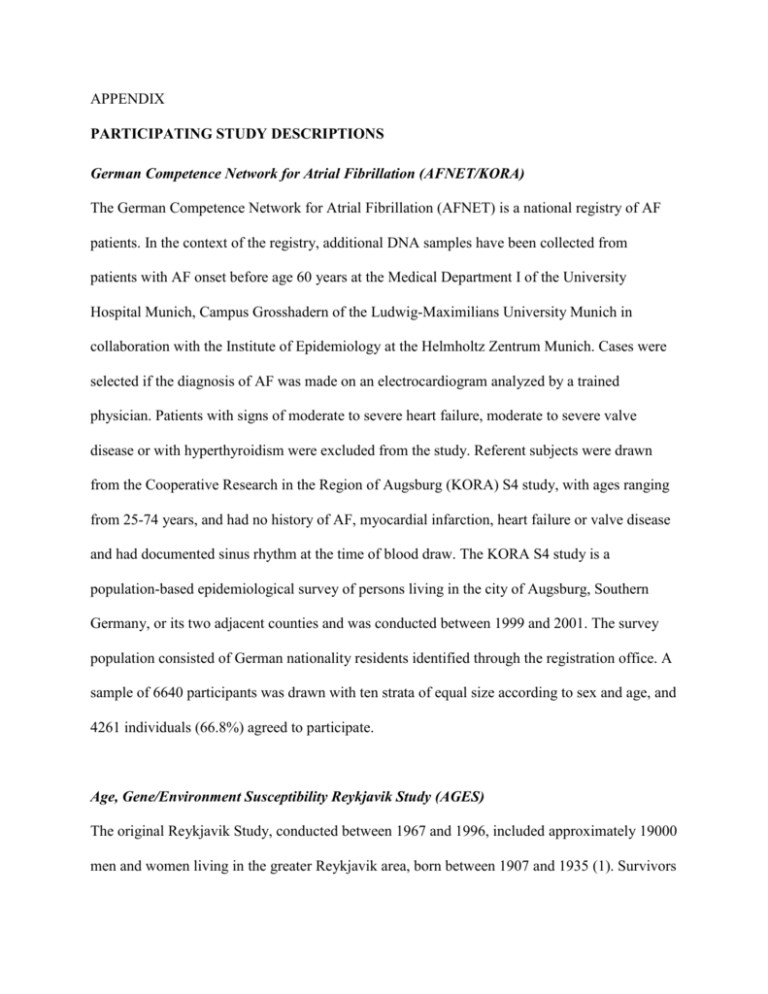
APPENDIX PARTICIPATING STUDY DESCRIPTIONS German Competence Network for Atrial Fibrillation (AFNET/KORA) The German Competence Network for Atrial Fibrillation (AFNET) is a national registry of AF patients. In the context of the registry, additional DNA samples have been collected from patients with AF onset before age 60 years at the Medical Department I of the University Hospital Munich, Campus Grosshadern of the Ludwig-Maximilians University Munich in collaboration with the Institute of Epidemiology at the Helmholtz Zentrum Munich. Cases were selected if the diagnosis of AF was made on an electrocardiogram analyzed by a trained physician. Patients with signs of moderate to severe heart failure, moderate to severe valve disease or with hyperthyroidism were excluded from the study. Referent subjects were drawn from the Cooperative Research in the Region of Augsburg (KORA) S4 study, with ages ranging from 25-74 years, and had no history of AF, myocardial infarction, heart failure or valve disease and had documented sinus rhythm at the time of blood draw. The KORA S4 study is a population-based epidemiological survey of persons living in the city of Augsburg, Southern Germany, or its two adjacent counties and was conducted between 1999 and 2001. The survey population consisted of German nationality residents identified through the registration office. A sample of 6640 participants was drawn with ten strata of equal size according to sex and age, and 4261 individuals (66.8%) agreed to participate. Age, Gene/Environment Susceptibility Reykjavik Study (AGES) The original Reykjavik Study, conducted between 1967 and 1996, included approximately 19000 men and women living in the greater Reykjavik area, born between 1907 and 1935 (1). Survivors of this study were invited to be part of AGES, which recruited 5764 men and women in 20022006. Of these, 5427 had a complete clinic exam, and 4469 met inclusion criteria and were considered for this analysis. Atherosclerosis Risk in Communities Study (ARIC) The ARIC study recruited 15792 men and women, aged 45-64 years, from 4 communities in the United States (Forsyth County, NC; Washington County, MD; Jackson, MS; and suburbs of Minneapolis, MN) in 1987-89 (2). Participants were mostly white in the Minnesota and Washington County field centers, white and African-American in Forsyth County, and exclusively African-American in the Jackson field center. After study inception, participants had 3 follow-up examinations, each approximately 3 years apart. Cleveland Clinic Lone AF GeneBank Study (CCAF) The Cleveland Clinic Lone AF GeneBank Study is comprised of individuals aged ≥ 18 years with lone atrial fibrillation (AF), defined as that occurring in the absence of significant structural heart disease. Participants had a history of recurring or persistent lone AF, ≤ 50% coronary artery stenosis in the coronary arteries (if cardiac catheterization done) or with normal stress test results (documentation of normal cardiac catheterization or stress test required if age ≥ 50 years), and had normal left ventricular ejection fraction (LVEF) ≥ 50%. Subjects were excluded if they had heart failure, history of significant valvular disease (>2+ valvular regurgitation, any valvular stenosis), significant coronary artery disease (>50% coronary artery stenosis), prior myocardial infarction, prior percutaneous coronary intervention, or coronary artery bypass graft, or latest LVEF <50%. Referent subjects were drawn from the Illumina iControlDB online database. Referent subjects were included if they came from iControlDB Studies 64, 65, 66 or 67. All referent subjects in those studies were identified as Caucasian. Age at DNA collection, sex, and race were the only available variables for the referent subjects. Cardiovascular Health Study (CHS) In 1989-90, CHS recruited 5201 men and women 65 years or older from 4 communities (Forsyth County, NC; Washington County, MD; Sacramento County, CA; and Pittsburgh, PA) (3). CHS participants had annual study exams through 1999; surveillance for cardiovascular events has been ongoing from baseline through the present. Included in this analysis were CHS participants of European ancestry who were free of clinically recognized myocardial infarction, stroke, and heart failure at baseline and who gave consent for research use of their genetic data. Framingham Heart Study (FHS) The FHS is a community-based observational, cohort study initiated in 1948 to prospectively investigate cardiovascular disease and its risk factors. The Original cohort (4) (n=5209) has received biennial exams. The Original Cohort children (& spouses), termed the Offspring cohort (5) (n=5214), were recruited in 1971, and are examined every four to eight years. At each FHS clinic examination, participants’ medical histories, physical examinations, and electrocardiograms were obtained to ascertain symptoms and findings suggestive of cardiovascular disease. Records of all interim hospitalizations for cardiovascular disease were sought for review. Participants were classified as having AF if either atrial flutter or fibrillation was present on an electrocardiogram obtained at an FHS clinic visit or encounter with an external clinician, Holter monitoring, or noted in hospital records. Two physicians adjudicated AF events in FHS (6). Heart and Vascular Health Study (HVH) The Heart and Vascular Health Study (HVH) is a study of incident AF in the setting of Group Health Cooperative, a large integrated health care system in Washington State, USA. All plan members assigned a new ICD-9 code of 427.31 or 427.32 in the inpatient or outpatient setting between 1 October 2001 and 31 December 2004 were identified. Incident AF was verified by review of medical records with the requirement that the AF be documented by 12-lead electrocardiogram and clinically recognized by a physician, with no previous evidence of AF in the medical record. Control subjects were identified from the Group Health membership, and had no history of AF. AF cases included in this analysis had early-onset AF; they were less than 66 years of age at AF diagnosis, without a history of coronary artery disease, valvular disease, heart failure, poor left ventricular function, chronic obstructive pulmonary disease, active cancer or hyperthyroidism. Referent subjects were identified from the enrollment of Group Health Cooperative, were 40-69 years old, and had no history of AF. LURIC The Ludwigshafen Risk and Cardiovascular Health (LURIC) study is an ongoing prospective study of more than 3,300 individuals of German ancestry in whom cardiovascular and metabolic phenotypes (CAD, MI, dyslipidemia, hypertension, metabolic syndrome and diabetes mellitus) have been defined or ruled out using standardized methodologies in all study participants. Inclusion criteria for LURIC were: German ancestry (limitation of genetic heterogeneity), clinical stability (except for acute coronary syndromes) and availability of a coronary angiogram. Exclusion criteria were: any acute illness other than acute coronary syndromes, any chronic disease where non-cardiac disease predominated and a history of malignancy within the last five years. Genome-wide analyses using the Affymetrix 6.0 have been completed in all participants. A 10-year clinical follow-up for total and cause specific mortality has been completed. Massachusetts General Hospital Atrial Fibrillation Study (MGH/MIGEN) The Massachusetts General Hospital Atrial Fibrillation Study (MGH) enrolled serial patients with lone AF or AF and hypertension referred to the arrhythmia service between July 5, 2001 and February 19, 2008. Inclusion criteria were AF documented by electrocardiography, and age less than 66 years. Individuals with structural heart disease as assessed by echocardiography, hyperthyroidism, myocardial infarction, or heart failure were excluded. Each patient underwent a physical examination and standardized interview. All patients were evaluated by 12-lead electrocardiogram, echocardiogram, and laboratory studies. Referent subjects were selected from the control population of the MIGEN study (7), and were healthy patients without a history of MI. PROSPER All data come from the PROspective Study of Pravastatin in the Elderly at Risk (PROSPER) (8). A detailed description of the study has been published elsewhere. PROSPER was a prospective multicenter randomized placebo-controlled trial to assess whether treatment with pravastatin diminishes the risk of major vascular events in elderly. Between December 1997 and May 1999, we screened and enrolled subjects in Scotland (Glasgow), Ireland (Cork), and the Netherlands (Leiden). Men and women aged 70-82 years were recruited if they had pre-existing vascular disease or increased risk of such disease because of smoking, hypertension, or diabetes. A total number of 5,804 subjects were randomly assigned to pravastatin or placebo. A large number of prospective tests were performed including BioBank tests and cognitive function measurements. A whole genome wide screening has been performed in the sequential PHASE project with the use of the Illumina 660K beadchip. Of 5,763 subjects DNA was available for genotyping. Genotyping was performed with the Illumina 660K beadchip, after QC (call rate <95%) 5,244 subjects and 557,192 SNPs were left for analysis. These SNPs were imputed to 2.5 million SNPs based on the HAPMAP built 36 with MACH imputation software. Rotterdam Study (RS-I, RS-II) The Rotterdam Study (RS) is a community-based study of elderly individuals from a suburb of Rotterdam with a focus on identifying determinants of health and cardiovascular, neurogeriatric, bone, and eye diseases (9). Participants age ≥55 years were examined up to 4 times every 3 years. AF was diagnosed based on study visit electrocardiograms, review of hospital discharge information, and general practitioner diagnoses. AF was verified by two physicians and disagreements settled by review of a cardiologist. The first cohort (RS I) was founded in 1990, and included 7,983 participants. The current analysis included 5,974 participants from RS-I that met inclusion criteria. The second cohort (RS II) was started in 2000 with the same inclusion criteria and included 3,011 participants. Of these 1,805 participants met inclusion criteria. Study of Health in Pomerania (SHIP) Study of Health in Pomerania (SHIP) is a longitudinal population-based cohort study in West Pomerania, a region in the northeast of Germany. SHIP was designed to assess prevalence and incidence of common risk factors, subclinical disorders and clinical diseases and to investigate complex associations among risk factors, subclinical disorders and clinical diseases. From the total population comprising 212,157 inhabitants in 1995, a two-stage stratified cluster sample of adults aged 20 to 79 years was drawn. From the net sample of 6,265 eligible subjects, 4,308 subjects (2,192 women) of European ancestry participated in the baseline examination, SHIP-0 (response 68.8%). During the baseline examination between 1997 and 2001 (SHIP-0) as well as during the 5-year follow-up examination between 2002 and 2006 (SHIP-1) resting electrocardiograms were digitally stored (Personal 120LD, Esaote, Genova, Italy) and processed by the MEANS ECG Interpretation and Measurement software (Welch Allyn, Skaneateles Falls, NY) according to the method described above for the RS. In addition, a Tele-ECG subproject was conducted in SHIP-1 to assess the prevalence of symptomatic and asymptomatic cardiac arrhythmias. Subjects were considered as having AF if it was present in at least one of these examinations. Women’s Genome Health Study (WGHS) The Women’s Genome Health Study (WGHS) is a prospective cohort comprised of over 25,000 initially healthy female health professionals enrolled in the Women’s Health Study, which began in 1993. All participants in WGHS provided baseline blood samples and extensive survey data. Women were asked to report diagnoses of AF at baseline, 48 months, and then annually thereafter. Beginning on September 19, 2006, women enrolled in the continued observational follow-up who reported an incident AF event after baseline on at least one yearly questionnaire were sent an additional questionnaire to confirm the episode and to collect additional information. They were also asked for permission to review their medical records, particularly available ECGs, rhythm strips, 24-hour ECGs, and information on cardiac structure and function. For all deceased participants who reported AF during the trial and extended follow-up period, family members were contacted to obtain consent and additional relevant information. An endpoint committee of physicians reviewed medical records for reported events according to predefined criteria. An incident AF event was confirmed if there was ECG evidence of AF or if a medical report clearly indicated a personal history of AF. The earliest date in the medical records when documentation was believed to have occurred was set as the date of onset of AF. Only confirmed events are included in this analysis. Prevalent AF events self reported at the beginning of the study were not confirmed by medical record review, although confirmation rates of selfreported AF in this cohort are high. BioBank Japan BioBank Japan is a hospital-based disease study of 47 common diseases including AF, in which 66 clinical hospitals in Japan have participated. Cases in this study are participants of BioBank Japan enrolled between 2003 and 2006. Control subjects included those with 11 diseases (hepatic cirrhosis, osteoporosis, colorectal cancer, breast cancer, prostate cancer, lung cancer, uterine myoma, amyotrophic lateral sclerosis, drug eruption, gallbladder and bile duct cancer and pancreatic cancer) registered in BioBank Japan and 906 healthy volunteers who were recruited from Osaka-Midosuji Rotary Club. In this analysis, principal components of ancestry were available for adjustment in a subset comprised of 844 cases, and all 3,393 control samples. FUNDING / SUPPORT AFNET/KORA: German National Genome Research Network NGFN 01GS0838, 01GR0803, BMBF-01EZ0874, 01GR0803, NGFN 01GI0204, 01GR0103, NGFN-2, NGFNPlus 01GS0823, and NGFNPlus 01GS0834; German Federal Ministry of research 01EZ0874; German Competence Network on AF (AFNET) 01 GI 0204/N; Leducq Foundation 07-CVD 03, BMBF spitzen cluster personalized medicine m4 (01 EX1021E), LMU Excellence Initiative (42595-6); Munich Center of Health Sciences (MC Health) as part of LMUinnovativ. The KORA research platform (KORA, Cooperative Research in the Region of Augsburg) was initiated and financed by the Helmholtz Zentrum München - German Research Center for Environmental Health, which is funded by the German Federal Ministry of Education and Research and by the State of Bavaria. Furthermore, KORA research was supported within the Munich Center of Health Sciences (MC Health), Ludwig-Maximilians-Universität, as part of LMUinnovativ. Dr. Sinner is supported by the German Heart Foundation. AGES: The Age, Gene/Environment Susceptibility Reykjavik Study has been funded by NIH contract N01-AG-12100, the NIA Intramural Research Program, Hjartavernd (the Icelandic Heart Association), and the Althingi (the Icelandic Parliament). ARIC: The Atherosclerosis Risk in Communities Study is carried out as a collaborative study supported by National Heart, Lung, and Blood Institute contracts (HHSN268201100005C, HHSN268201100006C, HHSN268201100007C, HHSN268201100008C, HHSN268201100009C, HHSN268201100010C, HHSN268201100011C, and HHSN268201100012C), R01HL087641, R01HL59367 and R01HL086694; National Human Genome Research Institute contract U01HG004402; and National Institutes of Health contract HHSN268200625226C. The authors thank the staff and participants of the ARIC study for their important contributions. Infrastructure was partly supported by Grant Number UL1RR025005, a component of the National Institutes of Health and NIH Roadmap for Medical Research. This work was additionally supported by grants RC1-HL-099452 from the National Heart, Lung, and Blood Institute and 09SDG2280087 from the American Heart Association. CCAF: R01 HL090620 from the National Heart, Lung, and Blood Institute (Chung, Barnard, J. Smith, Van Wagoner); NIH/NCRR, CTSA 1UL-RR024989 (Chung, Van Wagoner); Heart and Vascular Institute, Department of Cardiovascular Medicine, Cleveland Clinic (Chung); Leducq Foundation 07-CVD 03 (Van Wagoner, Chung); Atrial Fibrillation Innovation Center, State of Ohio (Van Wagoner, Chung). CHS: This CHS research was supported by NHLBI contracts HHSN268201200036C, HHSN268200800007C, N01HC55222, N01HC85079, N01HC85080, N01HC85081, N01HC85082, N01HC85083, N01HC85086; and NHLBI grants HL080295, HL087652, HL105756 with additional contribution from the National Institute of Neurological Disorders and Stroke (NINDS). Additional support was provided through AG023629 from the National Institute on Aging (NIA). A full list of CHS investigators and institutions can be found at http://www.chs-nhlbi.org/pi.htm. The provision of genotyping data was supported in part by the National Center for Advancing Translational Sciences, CTSI grant UL1TR000124, and the National Institute of Diabetes and Digestive and Kidney Disease Diabetes Research Center (DRC) grant DK063491 to the Southern California Diabetes Endocrinology Research Center. FHS: Our research was conducted using data and resources from FHS of the National Heart Lung and Blood Institute of the National Institutes of Health and Boston University School of Medicine based on analyses by Framingham Heart Study investigators participating in the SNP Health Association Resource (SHARe) project. The work was supported by Contract No. N01HC-25195 and its contract with Affymetrix, Inc for genotyping services Contract No.N02-HL-64278. A portion of this research utilized the Linux Cluster for Genetic Analysis (LinGA-II) funded by the Robert Dawson Evans Endowment of the Department of Medicine at Boston University School of Medicine and Boston Medical Center. Other support came from 1R01 HL092577; 1RO1 HL076784; 1R01 AG028321; Evans Center for Interdisciplinary Biomedical Research ARC on Atrial Fibrillation at Boston University (http://www.bumc.bu.edu/evanscenteribr/the-arcs/the-arcs/ (Benjamin), 6R01-NS 17950 and American Heart Association 09FTF2190028. HVH: The Heart and Vascular Health Study is supported by grant numbers R01 HL 068986, R01 HL085251, and R01 HL073410 from the National Heart Lung and Blood Institute. LURIC: LURIC has received funding from the 6th Framework Program (integrated project Bloodomics, grant LSHM-CT-2004-503485) and from the 7th Framework Program (Atheroremo, grant agreement number 201668 and RiskyCAD, grant agreement number 305739) of the European Union as well as from the INTERREG IV Oberrhein Program (Project A28, Genetic mechanisms of cardiovascular diseases) with support from the European Regional Development Fund (ERDF) and the Wissenschaftsoffensive TMO. MGH/MIGEN: This work was supported by NIH grants R01HL092577 (Ellinor and Benjamin), R01HL104156, K24HL105780 (Ellinor), K23HL114724 (Lubitz), and an American Heart Association Established Investigator Award 13EIA14220013 (Ellinor) and Fellow to Faculty Award 12FTF11350014 (Lubitz). PROSPER: The PROSPER study was supported by an investigator initiated grant obtained from Bristol-Myers Squibb. Prof. Dr. J. W. Jukema is an Established Clinical Investigator of the Netherlands Heart Foundation (grant 2001 D 032). Support for genotyping in PHASE was provided by the seventh framework program of the European commission (grant 223004) and by the Netherlands Genomics Initiative (Netherlands Consortium for Healthy Aging grant 050-060810). Rotterdam Study: The Rotterdam Study (RS) is supported by the Erasmus Medical Center and Erasmus University Rotterdam; The Netherlands Organization for Scientific Research; The Netherlands Organization for Health Research and Development (ZonMw); the Research Institute for Diseases in the Elderly; The Netherlands Heart Foundation; the Ministry of Education, Culture and Science; the Ministry of Health Welfare and Sports; the European Commission; and the Municipality of Rotterdam. Support for genotyping was provided by The Netherlands Organization for Scientific Research (NWO) (175.010.2005.011, 911.03.012) and Research Institute for Diseases in the Elderly (RIDE). This study was supported by The Netherlands Genomics Initiative (NGI)/Netherlands Organization for Scientific Research (NWO) project nr. 050-060-810. SHIP: SHIP is part of the Community Medicine Research net of the University of Greifswald, Germany, which is funded by the Federal Ministry of Education and Research (grants no. 01ZZ9603, 01ZZ0103, and 01ZZ0403), the Ministry of Cultural Affairs as well as the Social Ministry of the Federal State of Mecklenburg-West Pomerania. Generation of genome-wide data has been supported by the Federal Ministry of Education and Research (grant no. 03ZIK012) and a joint grant from Siemens Healthcare, Erlangen, Germany and the Federal State of Mecklenburg- West Pomerania. The University of Greifswald is a member of the ‘Center of Knowledge Interchange’ program of the Siemens AG. WGHS: The WGHS is supported by HL 099355 (Buring), HL 043851 (Buring) and HL 080467 (Buring) from the National Heart, Lung, and Blood Institute and CA 047988 (Buring) from the National Cancer Institute, the Donald W. Reynolds Foundation and the Fondation Leducq (Ridker), with collaborative scientific support and funding for genotyping provided by Amgen. AF endpoint confirmation was supported by HL-093613 (Albert) and a grant from the Harris Family Foundation (Tedrow). BioBank Japan: This study was supported by the Ministry of Education, Culture, Sports, Science, and Technology, Japan. Role of the Sponsor: None of the funding agencies had any role in the study design, data collection or analysis, interpretation of the data, writing of the manuscript, or in the decision to submit the manuscript for publication. Supplemental Methods Phylogenetic conservation The conservation score (represented as the phyloP score) was obtained from the UCSC Genome Browser, which was calculated by the multiple sequence alignment of 44 vertebrate species. More information is available at http://genome.ucsc.edu/cgibin/hgTrackUi?hgsid=342995335&c=chr4&g=cons44way. Regions surrounding the identified non-redundant SNPs from the conditional analysis and flanked by 5 kb on either side (upstream and downstream) were identified, and conservation scores across these regions were averaged. In order to calculate the conservation score at the remainder of the chromosome 4q25 locus, we averaged the conservation scores across the region centered on SNP rs6817105 and flanked by 1 Mb on either side (upstream and downstream), minus the non-redundant regions described above. The conservation scores were compared between the non-redundant regions and the remainder of the chromosome 4q25 locus with the Student’s t-test assuming equality of variances. Supplemental Table 1. Details regarding study samples, genotyping and data cleaning. AFNET / MGH / AGES ARIC CHS CCAF FHS HVH LURIC KORA MIGEN CardioCleveland Framingham Heart and Ludwigshafen Mass. Study German AF Age, Gene/ Atherosclerosis Network Environment Risk in vascular Clinic AF Heart Study Vascular Risk and General Susceptibility Communities Health Study Study Health Cardiovascular Hospital AF Study Study Study Health Study Study & MIGEN (12) (13,14) (15) (4,16) Design (10,11) papers Illumina Affymetrix 6.0 Illumina 370 Illumina Affymetrix Array Illumina HumanCN HumanCNV37 CNV Hap550 v1 or Gene Chip® V370 0-Duo v3 and 500K Array And BeadChip Hap610 v1 Set Illumina & 50K Human550 Human K Gene Focused Panel Birdseed BeadStudio BeadStudio Bayesian Callin BeadStudio BeadStudio Robust g Linear Algori Modeling thm <98% <97% <95% <97% <95% <97% Per SNP Call rate <10-5 <10-6 <10-6 <10-5 FDR < 0.20 <10-6 HWE pvalue NA NA NA ≤2 NA N>100 Mend elian errors ND NA NA ND FDR < 0.01 subject Excess heterohetero zygosity >5 zygosi SD away ty from the mean <5% <1% <1% Excluded <5% <1% MAF SNPs with 0 heterozygotes (17) (18) (19) Illumina Affymetrix 6.0 Affymetrix 370 CNV 6.0 PHASE / RS-I PROSPER PHArmacogenetic Rotterdam Study-! study of Statins in the Elderly at risk / PROspective Study of Pravastatin in the Elderly at Risk for vascular disease (8,20) (9) Illumina 660K beadchip RS-II Rotterdam Study-II (9) SHIP WGHS The Study of Women’s Health in Genome Pomerania Health Study (21) (22) BioBank Japan BioBank Japan (23) Illumina Illumina550K Affymetrix Illumina Illumina Infinium Duo, 610KQuad 6.0 HumanHap3 Human610HumanHap5 00 Duo+ Quad and 50Illumina chip v3.0 Human Hap550v3 BeadChip BeadStudio Birdseed Birdseed Beadstudio BeadStudio <97% < 98% <97% <98% <98% <98% ND <90% <99% <10-5 <10-4 <10-6 <10-6 <10-6 <10-6 ND <10-6 <10-6 ≤2 NA NA NA NA NA NA NA NA ND ND ND subject heterozygosity >4 SD away from the mean ND ND ND Excluded SNPs with 0 heterozygot < 1% <1% <1% ND <1% <1% GenomeStudio >0.336; n=21 >0.336; n=21 <1% <1% BeadStudio BeadStudio BeadStudio v2 AFNET / KORA Selecti on criteri a for PCs P<0.05 4 Numb er of PCs in the model Numb 315,972 er of SNPs used for imput ation Imput Mach1 v ation 1.0.10(24) softwa re Imput Build 35 ation Backb one / NCBI Build Build 35 SNP positio n from NCBI AGES ARIC CHS CCAF FHS PCs examined P< 0.0005 All PCs in relation to unassociated, incident and p>0.05 prevalent AF. Bonferroni adjusted P value threshold to determine whether PCs were associated with AF. 6 0 HVH LURIC MGH / MIGEN es ND ND P<0.05 NA NA 6 4 NA NA 0 1 EV for incident AF, 3 EVs for prevalent AF 2 305,353 686,195 638,338 557,192 530,683 537,405 869,224 331959 31,927 P<0.05 Eigenstrat: anyone >8 SD from top 10 PCs was removed (225/9747 individuals) NA NA 308,340 602,642 306,655 460,569 Mach1 v 1.0.16(24) Mach1 v 1.0.16(24) BIMBAM Mach1 v 1.0.16(24) Build 36 Build 36 Build 36 Build 36 Build 36 Build 36 Build 36 Build 36 Build 36 Build 36 Build 36 Build 36 Build 36 Build 36 385,958 Mach1 v BIMBAM( 1.0.15(24) 25) Mach 1 v 1.0.16(24) HapMap II CEU r22 PHASE / PROSPER RS-I RS-II SHIP WGHS BioBank Japan Outliers as Outliers as Outliers as AF, adjusted Association Within ± identified by IBS identified by identified by for sex+age, with AF 0.02 from clustering were IBS IBS clustering was (p<0.05) centroid for excluded clustering were excluded associated both were with the PC components excluded (p<0.05), tested for first 10 PCs obtained from EIGENSTR AT Mach1 Mach1 v 1.0.15(24) Mach1 v Machv1.0.16(24 IMPUTEv0.5 Mach1 v. SHAPEIT v2 v1.0.16(24) 1.0.15(24) ) .0 against 1.0.16(24) r71 + HapMap II HapMap II IMPUTEv2.3 CEU v22 CEU r22 .0against 1000 Genomes Integrated Phase 1 v3 Build 36 Build 36 Build 36 Build 36 Build 36 Build 36 Build 37 (GRCh37) Build 36 Build 36 Build 36 Build 36 Build 36 Build 36 Build 37 (GRCh37) AFNET / KORA AGES ARIC CHS CCAF FHS HVH LURIC MGH / MIGEN build R(27) ProbABEL, R R(27) GWA ProbABEL ProbABEL(26) ProbABEL(26) R, version 2.7 ProbABEL(2 R packages (26), R(27) , R(27) , PLINK(28), 6), R(27) kinship, S R(27) GEE, Statist COXPH (27) ical Analy sis 2,408,991 2,512,759 I:2,319,581 2,509,367 I: 2501666 2,316,203 2,543,887 2,508,401 Total 2,521,723 P: 2,317,847 P: 2501188 numb er of SNPs used in the analys is (MAF >0.005 ) 1.02 I: 1.005 1.007 I: 1.045 1.034 I:1.017 1.09 0.997 1.022 Inflati P:1.062 P: 1.038 P:1.038 on factor (λ) Abbreviations: NA, not available. PLINK, http://pngu.mgh.harvard.edu/purcell/PLINK/ Eigenstrat, http://genepath.med.harvard.edu/~reich/Software.htm MACH, http://www.sph.umich.edu/csg/abecasis/MaCH/index.html BIMBAM, http://stephenslab.uchicago.edu/software.html PHASE / PROSPER RS-I RS-II SHIP WGHS BioBank Japan ProbABEL Mach2QTL Mach2QTL QUICKTES ProbABEL, GenABEL + GenABEL + T v0.94 R PLINK, PLINK, R(27), R(27), GRIMP(29) GRIMP(29) R, version 2.10.0 2,543,887 I: 2,502,002 P: 2,501,903 2,541,494 2,598,639 2,608,508 430,963 I:1.035 P:1.024 1.006 0.998 1.017 1.03 Supplemental Table 2. Construction of genetic risk score categories. Unweighted Weighted Chromosome 4q25 All loci Chromosome 4q25 All loci score<0.5 = 0 score<0.5 = 0 score<0.106 = 1 score<0.922 = 1 score≥0.5 & score<1.5 = score≥0.5 & score<2.5 score≥0.106 & score≥0.922 & 1 =2 score<0.145 = 2 score<1.072 = 2 score≥1.5 & score<2.5 = score≥2.5 & score<4.5 score≥0.145 & score≥1.072 & 2 =4 score<0.214 = 3 score<1.179 = 3 score≥2.5 & score<3.5 = score≥4.5 & score<6.5 score≥0.214 & score≥1.179 & 3 =6 score<0.230 = 4 score<1.282 = 4 score≥3.5 & score<4.5 = score≥6.5 & score<8.5 score≥0.230 & score≥1.282 & 4 =8 score<0.325 = 5 score<1.385 = 5 score≥4.5 & score<5.5 = score≥8.5 & score≥0.325 & score≥1.385 & 5 score<10.5 = 10 score<0.370 = 6 score<1.487 = 6 score≥5.5 & score<6.5 = score≥10.5 & score≥0.370 & score≥1.487 & 6 score<12.5 = 12 score<0.557 = 7 score<1.588 = 7 score≥6.5 & score<7.5 = score≥12.5 & score≥0.557 & score≥1.588 & 7 score<14.5 = 14 score<0.692 = 8 score<1.749 = 8 score≥7.5 & score<8.5 = score≥14.5 & score≥0.692 & score≥1.749 & 8 score<16.5 = 16 score<0.815 = 9 score<1.943 = 9 score≥16.5 & score≥0.815 = 10 score≥1.943 = 10 score<18.5 = 18 score≥18.5 & score<20.5 = 20 score≥20.5 & score<22.5 = 22 score≥22.5 & score<24.5 = 24 Weights were applied as follows: 0.13*rs3903239_G; 0.17*rs6666258_C; 0.12*rs1448818_C; 0.48*rs6817105_C; 0.25*rs4400058_A; 0.11*rs6838973_C; 0.13*rs3807989_G; 0.12*rs10821415_A; 0.16*rs10824026_A; 0.13*rs1152591_A; 0.15*rs7164883_G; 0.21*rs2106261_T Supplemental Table 3. Linkage disequilibrium between identified susceptibility signals at chromosome 4q25. rs1448818* rs2723288 rs6817105* rs4400058* rs4032974 rs17570669 rs3853445 rs6838973* – 0.523 0.001 0.026 0.026 0.016 0.061 0.014 rs1448818* – 0.001 0.044 0.044 0.016 0.053 0.001 rs2723288 – 0.017 0.017 0.037 0.009 0.017 rs6817105* – 1 0.011 0.007 0.001 rs4400058* – 0.011 0.007 0.001 rs4032974 – 0.114 0.093 rs17570669 – 0.308 rs3853445 – rs6838973* All values represent r2. Data from the HapMap CEU panel release 22. *Carried forward as non-redundant signals as described in the methods. Supplemental Table 4. Relations between non-redundant signals at the 4q25 locus and phylogenetic conservation. Start and Stop Positions (HG 19) P-value for comparison to remainder of 4q25 locus Mean conservation Chromosome 4q25 Region* score (± SD)† 110,705,7680.189825 ± Remainder of locus – 112,705,768 1.034205 0.2853925 ± Non-redundant signals < 2.2x10-16 – 1.159416 111,565,2230.1566212 ± rs1448818 0.001 111,575,223 1.027322 111,700,7680.1134964 rs6817105 1.4x10-13 111,710,768 ±1.027837 111,711,6730.5704372 ± rs4400058 < 2.2x10-16 111,721,673 1.322774 111,760,4950.3010151 ± rs6838973 < 2.2x10-16 111,770,495 1.178208 *For non-redundant signals, regions are defined as the SNP ± 5 kb. The remainder of the chromosome 4q25 locus excludes the regions surrounding the non-redundant signals. †Conservation score represented as phyloP score. Supplemental Table 5. Associations between non-redundant SNPs and AF in a subset of the BioBank Japan sample adjusted for principal components of ancestry. Entire sample N=7,916 cases / 3,393 controls Age- and sexadjusted AF risk / referent allele RR (95% CI) Subset N=844 cases / 3,393 controls Age-, sex- and principal componentadjusted RR (95% CI) Adjusted for SNPs on chromosome 4q25 rs1448818 C/A 0.98 (0.90-1.06) 1.09 (0.95-1.25) rs6817105 C/T 1.92 (1.76-2.10) 1.91 (1.63-2.24) rs4400058 A/G 1.43 (1.30-1.58) 1.53 (1.29-1.83) rs6838973 C/T 1.12 (1.04-1.20) 1.09 (0.95-1.22) Adjusted for SNPs at all loci rs6666258 C/G 1.23 (0.91-1.67) 1.35 (0.81-2.24) rs3903239 G/A 1.12 (1.04-1.20) 1.18 (1.05-1.34) rs1448818 C/A 0.97 (0.89-1.06) 1.09 (0.95-1.26) rs6817105 C/T 1.90 (1.74-2.08) 1.92 (1.64-2.25) rs4400058 A/G 1.42 (1.29-1.57) 1.56 (1.31-1.87) rs6838973 C/T 1.11 (1.03-1.20) 1.08 (0.95-1.22) rs3807989 G/A 1.25 (1.16-1.35) 1.35 (1.18-1.53) rs10821415 A/C 1.08 (0.99-1.17) 1.12 (0.97-1.28) rs10824026 A/G 0.94 (0.88-1.01) 0.95 (0.84-1.07) rs1152591 A/G 1.02 (0.94-1.10) 1.11 (0.98-1.27) rs7164883 G/A 0.97 (0.86-1.08) 0.99 (0.82-1.20) rs2106261 T/C 1.28 (1.19-1.38) 1.38 (1.21-1.57) Principal components of ancestry were available for the subset of 844 cases and 3,393 controls with genome-wide data available. Supplemental Table 6. Characteristics of the survival sample. Time to Death (Survival) N total N events Mean follow-up (years) Male Age 25,007 8,444 10.6 (5.4) 45% 69.0 (8.9) Time to Disease or Death (Survival Free of Major Disease) 16,995 7,314 8.8 (5.7) 44% 67.7 (8.5) Supplemental Table 7. Associations between AF associated SNPs and survival or survival free of major disease or mortality. Survival Survival free of major disease or mortality SNP and AF Chromosomal AF risk allele AF risk allele risk allele locus frequency RR (95% CI) P value frequency RR (95% CI) P value 1q21 / KCNN30.99 (0.95rs6666258_C PMVK 0.29 1.02) 0.47 0.29 0.99 (0.96-1.03) 0.75 1.04 (1.016.6x10 3 rs3903239_G 1q24 / PRRX1 0.44 1.08) 0.44 1.04 (1.01-1.08) 0.02 0.99 (0.95rs1448818_C 4q25 / PITX2 0.25 1.02) 0.41 0.25 0.98 (0.95-1.02) 0.44 0.99 (0.94rs6817105_C 4q25 / PITX2 0.12 1.04) 0.62 0.13 0.97 (0.92-1.02) 0.26 1.05 (0.99rs4400058_A 4q25 / PITX2 0.10 1.10) 0.09 0.10 1.00 (0.95-1.06) 0.95 1.00 (0.97rs6838973_C 4q25 / PITX2 0.56 1.03) 0.81 0.57 1.00 (0.96-1.03) 0.83 1.02 (0.99rs3807989_G 7q31 / CAV1 0.59 1.05) 0.26 0.59 1.02 (0.98-1.05) 0.31 1.00 (0.97rs10821415_A 9q22 / C9orf3 0.42 1.04) 0.80 0.42 1.02 (0.99-1.06) 0.20 0.98 (0.94rs10824026_A 10q22 / SYNPO2L 0.84 1.02) 0.35 0.84 1.01 (0.96-1.06) 0.68 1.02 (0.99rs1152591_A 14q23 / SYNE2 0.47 1.05) 0.24 0.47 1.00 (0.97-1.04) 0.82 1.00 (0.96rs7164883_G 15q24 / HCN4 0.15 1.04) 0.96 0.15 1.02 (0.97-1.07) 0.38 1.00 (0.96rs2106261_T 16q22 / ZFHX3 0.17 1.05) 0.88 0.17 1.01 (0.96-1.05) 0.76 Analyses adjusted for age, sex, and principal components of ancestry. Supplemental Figure 1. Location of atrial fibrillation susceptibility signals and at the chromosome 4q25 locus and relations with phylogenetic conservation and regulatory elements. Each susceptibility signal is marked by a vertical hash and the SNP rsID tagging the signal. Regions containing SNPs with an r2≥0.9 with each susceptibility signal are highlighted with a black bar above the respective SNP. Select tracks from the UCSC genome browser are also shown and include RefSeq genes, nucleotide conservation across non-placental vertebrate and mammalian species, and several ENCODE tracks including H3K27Ac marks from 7 cell lines (a marker for the H3 histone protein acetylation which may be associated with enhanced transcription), CpG methylation sites (a marker for promoter sites at which methylation may regulate transcription), DNase I hypersensitivity areas across 125 cell types (markers for regulatory regions), and transcription factor sites as assayed by ChIP-seq. Full details are available at http://genome.ucsc.edu. Supplemental Figure 2. Weighted genetic risk models in the AFGEN and BioBank Japan samples. Associations between categories of weighted risk scores with AF relative to the lowest category are displayed for scores comprised of independent SNPs from A) chromosome 4q25 and B) all loci. Score categories were defined based upon deciles of score distributions in the MGH sample. Supplemental References 1. 2. 3. 4. 5. 6. 7. 8. 9. 10. 11. 12. 13. 14. 15. 16. Harris TB, Launer LJ, Eiriksdottir G et al. Age, Gene/Environment SusceptibilityReykjavik Study: multidisciplinary applied phenomics. Am J Epidemiol 2007;165:10761087. The ARIC Investigators. The Atherosclerosis Risk in Communities (ARIC) study: design and objectives. Am J Epidemiol 1989;129:687-702. Fried LP, Borhani NO, Enright P et al. The Cardiovascular Health Study: design and rationale. Ann Epidemiol 1991;1:263-276. Dawber TR, Meadors GF, Moore FE, Jr. Epidemiological approaches to heart disease: the Framingham Study. Am J Public Health Nations Health 1951;41:279-81. Feinleib M, Kannel WB, Garrison RJ, McNamara PM, Castelli WP. The Framingham Offspring Study. Design and preliminary data. Prev Med 1975;4:518-25. Fuster V, Ryden LE, Cannom DS et al. ACC/AHA/ESC 2006 Guidelines for the Management of Patients with Atrial Fibrillation: a report of the American College of Cardiology/American Heart Association Task Force on Practice Guidelines and the European Society of Cardiology Committee for Practice Guidelines (Writing Committee to Revise the 2001 Guidelines for the Management of Patients With Atrial Fibrillation): developed in collaboration with the European Heart Rhythm Association and the Heart Rhythm Society. Circulation 2006;114:e257-354. Kathiresan S, Voight BF, Purcell S et al. Genome-wide association of early-onset myocardial infarction with single nucleotide polymorphisms and copy number variants. Nat Genet 2009;41:334-41. Shepherd J, Blauw GJ, Murphy MB et al. Pravastatin in elderly individuals at risk of vascular disease (PROSPER): a randomised controlled trial. Lancet 2002;360:1623-30. Hofman A, Breteler MM, van Duijn CM et al. The Rotterdam Study: 2010 objectives and design update. Eur J Epidemiol 2009;24:553-72. Holle R, Happich M, Lowel H, Wichmann HE, Group MKS. KORA--a research platform for population based health research. Gesundheitswesen 2005;67 Suppl 1:S19-25. Wichmann HE, Gieger C, Illig T. KORA-gen--resource for population genetics, controls and a broad spectrum of disease phenotypes. Gesundheitswesen 2005;67 Suppl 1:S26-30. Harris TB, Launer LJ, Eiriksdottir G et al. Age, Gene/Environment SusceptibilityReykjavik Study: multidisciplinary applied phenomics. Am J Epidemiol 2007;165:107687. The Atherosclerosis Risk in Communities (ARIC) Study: design and objectives. The ARIC investigators. Am J Epidemiol 1989;129:687-702. Alonso A, Agarwal SK, Soliman EZ et al. Incidence of atrial fibrillation in whites and African-Americans: the Atherosclerosis Risk in Communities (ARIC) study. Am Heart J 2009;158:111-7. Fried LP, Borhani NO, Enright P et al. The Cardiovascular Health Study: design and rationale. Ann Epidemiol 1991;1:263-76. Kannel WB, Feinleib M, McNamara PM, Garrison RJ, Castelli WP. An investigation of coronary heart disease in families. The Framingham offspring study. Am J Epidemiol 1979;110:281-90. 17. 18. 19. 20. 21. 22. 23. 24. 25. 26. 27. 28. 29. Heckbert SR, Wiggins KL, Glazer NL et al. Antihypertensive treatment with ACE inhibitors or beta-blockers and risk of incident atrial fibrillation in a general hypertensive population. American journal of hypertension 2009;22:538-44. Winkelmann BR, Marz W, Boehm BO et al. Rationale and design of the LURIC study--a resource for functional genomics, pharmacogenomics and long-term prognosis of cardiovascular disease. Pharmacogenomics 2001;2:S1-73. Ellinor PT, Yoerger DM, Ruskin JN, MacRae CA. Familial aggregation in lone atrial fibrillation. Hum Genet 2005;118:179-84. Trompet S, de Craen AJ, Postmus I et al. Replication of LDL GWAs hits in PROSPER/PHASE as validation for future (pharmaco)genetic analyses. BMC Med Genet 2011;12:131. Volzke H, Alte D, Schmidt CO et al. Cohort profile: the study of health in Pomerania. Int J Epidemiol 2011;40:294-307. Ridker PM, Chasman DI, Zee RY et al. Rationale, design, and methodology of the Women's Genome Health Study: a genome-wide association study of more than 25,000 initially healthy american women. Clin Chem 2008;54:249-55. Nakamura Y. The BioBank Japan Project. Clin Adv Hematol Oncol 2007;5:696-7. Li Y, Willer CJ, Ding J, Scheet P, Abecasis GR. MaCH: using sequence and genotype data to estimate haplotypes and unobserved genotypes. Genetic epidemiology 2010;34:816-34. Guan Y, Stephens M. Practical issues in imputation-based association mapping. PLoS Genet 2008;4:e1000279. Aulchenko YS, Ripke S, Isaacs A, van Duijn CM. GenABEL: an R library for genomewide association analysis. Bioinformatics 2007;23:1294-6. R Development Core Team. R: A language and environment for statistical computing. Vienna, Austria: R Foundation for Statistical Computing, 2006. Purcell S, Neale B, Todd-Brown K et al. PLINK: a tool set for whole-genome association and population-based linkage analyses. Am J Hum Genet 2007;81:559-75. Estrada K, Abuseiris A, Grosveld FG, Uitterlinden AG, Knoch TA, Rivadeneira F. GRIMP: a web- and grid-based tool for high-speed analysis of large-scale genome-wide association using imputed data. Bioinformatics 2009;25:2750-2.
